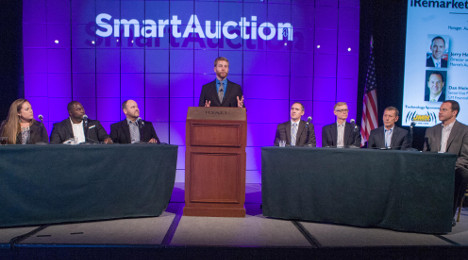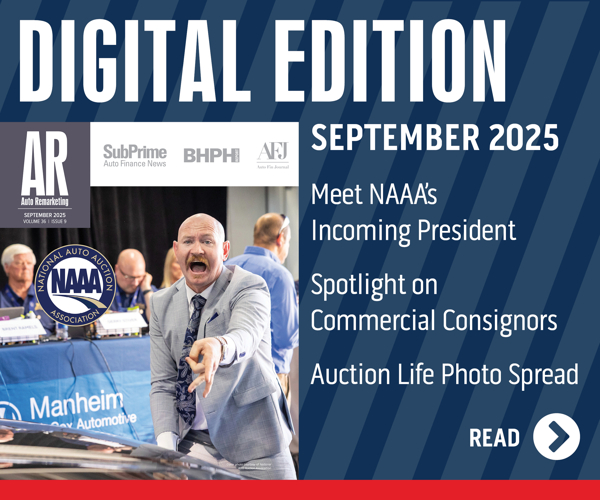Condition Grade Standard Builds Consistency

During a panel discussion on multi-platform selling at Used Car Week this fall, GM Financial’s Dan Heinrich expressed a concern.
He said one of the hurdles to this type of online wholesaling gaining widespread traction in the remarketing business was inconsistency with condition reports.
Flash forward a couple months, and the industry may have found a solution to this potential road block, Heinrich said.
In mid-January, Auto Auction Services Corp. announced a new industry standard for vehicle condition data reporting — developed in partnership with Manheim — that is designed to foster consistency throughout the business.
AASC said in its announcement that thanks to a deal with the National Auto Auction Association, it would soon be providing AASC member auctions with Manheim’s AutoGrade service, which aims to provide a consistent condition grading scale throughout the industry, regardless of platform, provider or location.
This was what the industry needed to help push this consistency, Heinrich told Auto Remarketing in a February interview.
“Until there was standardization around condition reports, you would have different condition reports on different platforms,” Heinrich said, noting this can lead to a “bad experience” for dealers.
However, the standardization the AutoGrade program offers allows for a “better experience for dealers” and helps make the multi-platform wholesale environment possible, he said.
But it’s not just dealers who benefit.
Heinrich, who is the co-chair of the Standards & Vehicle Certification Committee for the International Automotive Remarketers Alliance, said NAAA worked closely with IARA to get the perspective of the consignors as this program was developed.
After all, consignors are affected by condition report grading, as well.
The exact same vehicle could have different condition report scores depending on location or the auction where it was being sold, Heinrich explained. And the score can certainly impact how much a dealer is willing to pay for the car.
With the standardization, it cuts away room for human error, and instead, breeds consistency.
These were also some of the key points of emphasis for Mike Broe, the chief executive officer and president of AASC, and his team.
When interviewed by Auto Remarketing in February, Broe said the big benefit to AutoGrade is having a consistent grading process. Buyers will have confidence in what the grade says about a car and know that it’s applicable across all platforms.
Buyers and sellers, he said, will have “confidence about what the grade means and how it is derived.”
To emphasize the consistency aspect, Broe puts it like this: every car has a condition, regardless of who owns or buys it. And when that condition is reported accurately, the value of that car is enhanced.
The more details about the car and its condition that you can share, Broe says, the greater likelihood the right buyers will be in the right place to drive the most value as possible for that car.
So, how is the condition grade generated via AutoGrade?
Broe explained that the automated system takes information from the inspection provider and runs it through an automated algorithm. This is designed to reduce human error or subjective grading.
Where AASC and AutoIMS product come into play is serving as a filter, Broe said. To request an AutoGrade score, auctions send the vehicle damage information to AASC through AutoIMS.
AASC sends the necessary information to Manheim after removing all data on the vehicle like VIN, year, make/model and the auction’s name. This is done for “competitive reasons,” Broe said, and gives the requester another layer of comfort knowing their data is protected.
AutoIMS then receives the AutoGrade score back from Manheim and sends it to the requester.
“No matter what year or who’s done the research, the No. 1 pain point for customers is vehicle information. They want consistent vehicle information,” Manheim executive vice president and chief operating officer Janet Barnard told Auto Remarketing at the NADA Convention & Expo in late January.
“And AutoGrade applies as much science to the completion of the condition reports as there has ever been,” she added.
“And while it’s still imperfect, our customers have said, ‘This is the best we’ve seen. And we wish that we would have this on every car that we buy or sell,’” Barnard continued. “So, knowing that it’s our customers’ No. 1 pain point, we proactively offered it up to the industry.
“It’s a patented technology, so we need to maintain ownership … but we are licensing it at no charge to anyone in the industry who wants to sign up for it. That side of the process has just now begun, and I would imagine the exposure that we’ll get with it at NADA, we’ll probably have a bit more interest after the show.”
As of mid-February, the program had been rolled out to one auction, Greensboro Auto Auction. The tool is live, and Greensboro AA is already using it. Broe said the response from Greensboro has been positive.
One thing AASC has learned from the initial rollout is that these reports — where, basically, a “line-by-line matching has to happen” — will require some work on the part of the auction to make sure all items on the inspection list are completed and to speak up if additional resources are needed to complete the task.
Jerry Barker, general manager of Greensboro Auto Auction, recognized this need for standardization and sees the benefits for buyers and consignors alike.
“I think a lot of buyers and consignors like to look at the grades of the cars as a way to price or buy a vehicle. And with all of us having different criteria … it makes it hard to have consistency. With all of us going to the same grading system, it will give us a consistency.”
While it still hinges on the inspector doing a solid job, a consignor will know that a 3.2 grade on a car, for example, should mean the same thing at one auction as it does at another location. This gives the consignor and the buyer a consistent way to classify cars based on the grading system, regardless of auction.
And beyond the actual score, it’s also key that the industry has a consistent way of classifying and referring to individual items within a report — everything from a left-front fender to burn marks or scratches.
“The way everybody classifies that (individual item) or what they call that, we have to make those match up with each other. I can see where a dealer could see some inconsistencies, so this will give us all a better gauge of what we call certain items, and we’ll have the consistency across the industry that when a dealer sees ‘LFR,’ that’s ‘left front door,’” Barker said, giving one example.
What all of this has brought to bear has been multiple parties — some competitors, even — coming together to work for the good of the overall business.
Heinrich sees it as a “big step” for the industry in that competitors are working together for something that that see as beneficial for all parties in the industry. And the same thing is happening with multi-platform selling, as well. He applauds this dialogue.
Similarly, Broe applauds the industry for embracing this effort at standardization and commends Manheim for making the program widely available.
Susie Heins, vice president of dealer sales at Manheim, says this collaborative effort goes back to transparency. And with the multi-platform online buying and selling, “everyone wants an even playing field,” she said.
“What it’s going to boil down to mean for the buyer is the experience that they receive, which I think forces all of us to look at how we’re delivering customer experience, in any channel, and then, is it consistent?” Heins said.
The industry has reached a realization with the new generation coming in, a consistent and easy customer experience is what they care about, and they’re experiencing for themselves on the retail side of their business, she said.
Barnard added: “We know as an industry, I don’t want to speak for our peers, but in the conversations we’ve had in the industry, we realize that if we don’t evolve and meet some of these customer needs like multi-platform selling, like AutoGrade, consistency across the nation, that as an industry we’re at risk.
“This isn’t a risk that’s greater for one provider than the other. It’s a risk in the industry,” she added. “So, we collectively are doing things to stay relevant, just as we are individually. We can differentiate individually, but collectively be relevant.”
And the latest development to this type of technology in the wholesale environment was the news revealed Thursday by several of the major players within the auction business. In a joint announcement, Manheim, ADESA and the independent auctions said they have made significant progress toward the creation of a multiplatform bidding solution that would facilitate simultaneous bidding on vehicles listed on multiple online auction sites.
The statement from these auction parties says that the proposed multiplatform solution is different from any other technology solution currently available in that it would allow a consigned car to receive bids from multiple online auctions from the moment the car is offered for sale until the time the car receives the winning bid.
A multiplatform steering committee has also been formed by Manheim, ADESA and representatives from the independent auctions. This committee will oversee the development of the industry-wide initiative.
There has also been a technical committee formed by industry representatives, who are approaching the final design of the architecture of the multiplatform bidding solution.
Additionally, the steering committee has brought in Auto Auction Services Corp. to build and maintain the hub technology used to facilitate the distribution of the inventory and the synchronization of the bidding activity between the multiple online platforms, the statement said.
For more on that story, see the Auto Remarketing article posted here.


